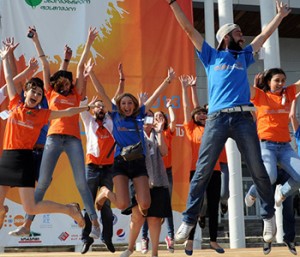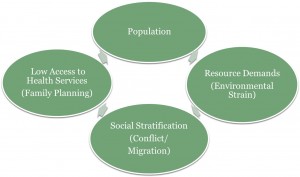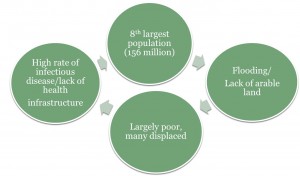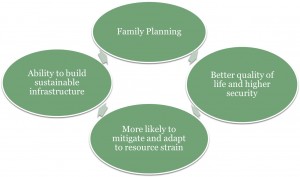Population is Complex, and That is a Good Thing
Jan 7th, 2015 | By admin | Category: Other ResourcesBy Kimberly Absher, guest youth blogger, www.howmany.org
Population is the proverbial elephant in the room of the world’s problems. Despite its massive importance in determining the fate of, well, everything, it is frequently ignored or glossed over. Meanwhile, 250,000 people are born every single day, many in resource-deprived areas. How do we change this? An excellent step for those of us involved with social, environmental, and political organizations is to make sure population is on the radar as we work toward our specific goals. Perhaps you are thinking that the cause you are passionate about has nothing to do with population, but I invite you to examine further.Population growth is connected to many issues. Hunger, violence, political instability, unemployment, climate change, water shortages, gender equality, human rights, agriculture, public health crises, education, deforestation…whew. The list of challenges in a dysfunctional relationship with population seems endless.
Women and Population
Personally, I am passionate about improving access to healthcare and women’s rights. My investment in these causes is inextricably linked to my commitment to population work. Without addressing population growth, neither healthcare access nor women’s rights is likely to make real, lasting progress. And without working toward health care as a universal human right and empowering women to decide if and when to have children, the population trajectory is likely to continue full force well into this century.
To illustrate the critical connections population has with just a few other issues, take a look at this chart:
This chart, made by yours truly, first shows the relationship between population and resource demands, which is pretty clear. More people = more stuff. This causes environmental strain through deforestation, biodiversity loss, pollution, and climate change. People begin to compete for resources, including jobs. Competition for work is challenging in youthful regions like the Middle East and North Africa (MENA) region. Places with a high percentage of youth tend to have less security and more political instability as well (e.g., Egypt).
Those who do not want to stay and fight try to find work elsewhere. The country they migrate to bears the influx of people, and often their economy is not prepared, so there is more conflict. In the face of low infrastructure and non-existent or overwhelmed social services, health problems erupt. Infectious disease is a result, as are unplanned pregnancies. Higher population is another result, and round and round we go.
Taking a Closer Look
Bangladesh is roughly the size of Iowa and home to 156 million people, with 45 percent of workers in the agricultural sector. Flooding, natural disasters, and a lack of arable land continue to take their toll on cultivating rice, the staple of Bangladeshi’s diet, and largest export.
People migrate in droves, mainly to India, searching for work. Migrants are more vulnerable to infectious diseases (particularly HIV and tuberculosis, common in poor living conditions), psychological problems, and lack of access to health services. Human trafficking for sex and labor is a significant problem. The lack of health care results in unplanned pregnancies and exacerbated poverty, continuing the cycle.
Meeting the Challenge!
Are you thoroughly depressed now? Don’t worry, there is some good news! Since population is so complex and is related to tons of other issues, there are countless ways to tackle the problem. Are you totally jazzed about sustainable farming practices? Great! Agriculture uses around 70 percent of the world’s water supply, so go forth and teach a less intensive way. Are you obsessed with books? Donate a few that changed your life, or volunteer to teach kids to read. Education (especially for girls) is hugely important in developing communities and is a factor in preventing unintended pregnancy.
If each of us does a little part of the puzzle, we can contribute to a much better cycle:
So, think of the social, political or environmental issues you care about most, and consider how they relate to population. I bet you can draw a connection. Then ask yourself what that issue needs in terms of time and resources, and see if there is something you can do. If you need an idea ask me, I’m happy to help. Together we can – nay, will – create a livable future.
Kimberly is a youth guest blogger with the Institute for Population Studies. She is currently a freelance writer on topics relating to health, women’s rights, and social change. You may reach Kimberly at kimberlyabsherwrites@gmail.com.




